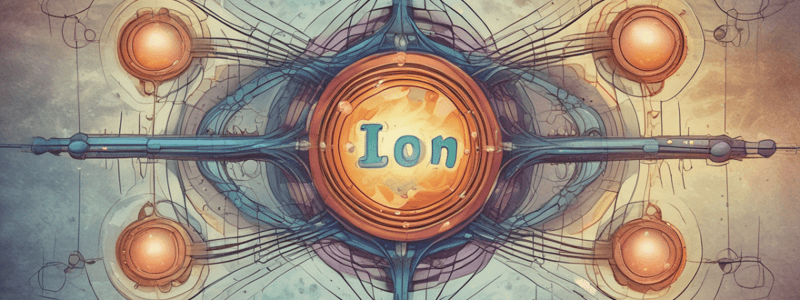Podcast
Questions and Answers
What is the charge on the hydroxide compound ion?
What is the charge on the hydroxide compound ion?
- -1 (correct)
- +2
- +1
- -2
Which type of ion is formed when fluorine gains electrons?
Which type of ion is formed when fluorine gains electrons?
- +1
- +2
- -1 (correct)
- -3
What is the electron configuration of a beryllium atom?
What is the electron configuration of a beryllium atom?
- 2.7
- 1
- 2.8.8.2
- 2.2 (correct)
Why do some ions attract while others repel?
Why do some ions attract while others repel?
What is the term for a strong force that joins atoms or ions together in molecules and giant lattices?
What is the term for a strong force that joins atoms or ions together in molecules and giant lattices?
What determines if an atom will form a positive ion?
What determines if an atom will form a positive ion?
How do atoms form positive ions?
How do atoms form positive ions?
In the formation of a sodium ion, how many electrons are lost?
In the formation of a sodium ion, how many electrons are lost?
What happens to the charge of an atom when it forms a negative ion?
What happens to the charge of an atom when it forms a negative ion?
Which of the following elements is most likely to form a negative ion?
Which of the following elements is most likely to form a negative ion?
How is a chloride ion different from a chlorine atom?
How is a chloride ion different from a chlorine atom?
In the formation of a sulfide ion, why does sulfur gain 2 electrons?
In the formation of a sulfide ion, why does sulfur gain 2 electrons?
What is the charge on a fluoride ion?
What is the charge on a fluoride ion?
How do non-metal atoms typically form ions?
How do non-metal atoms typically form ions?
Why do negative ions have a 'small '-' symbol' before their chemical symbol?
Why do negative ions have a 'small '-' symbol' before their chemical symbol?
Flashcards are hidden until you start studying
Study Notes
Ions and Electron Configuration
- Atoms gain or lose electrons to complete their outer electron shell, forming ions with the same electron configuration.
- Example: oxygen and fluorine gain electrons to become negative ions with the same electron configuration.
Compound Ions
- A compound ion is made up of a group of atoms.
- Examples of compound ions: hydroxide (OH-), sulfate (SO42-), nitrate (NO3-), carbonate (CO32-), ammonium (NH4+).
Positive and Negative Ions
- Atoms with a nearly empty outer shell lose electrons to obtain a full outer shell, forming positive ions.
- Atoms with a nearly full outer shell gain electrons to obtain a full outer shell, forming negative ions.
Formation of Positive Ions
- Atoms that lose one or more electrons form positive ions.
- Examples: lithium (2.1 → Li+), magnesium (2.8.2 → Mg2+), aluminium (2.8.3 → Al3+).
Formation of Negative Ions
- Atoms that gain one or more electrons form negative ions.
- Examples: chlorine (2.8.7 → Cl-), oxygen (2.6 → O2-), nitrogen (2.5 → N3-).
Ion Charges
- The charge on an ion is indicated by a small '+' or '-' symbol and a number.
- The number is usually the same as the number of electrons lost or gained.
Ion Attraction and Conductivity
- Ions attract or repel each other due to their charges.
- Ionic compounds do not conduct electricity.
Studying That Suits You
Use AI to generate personalized quizzes and flashcards to suit your learning preferences.




